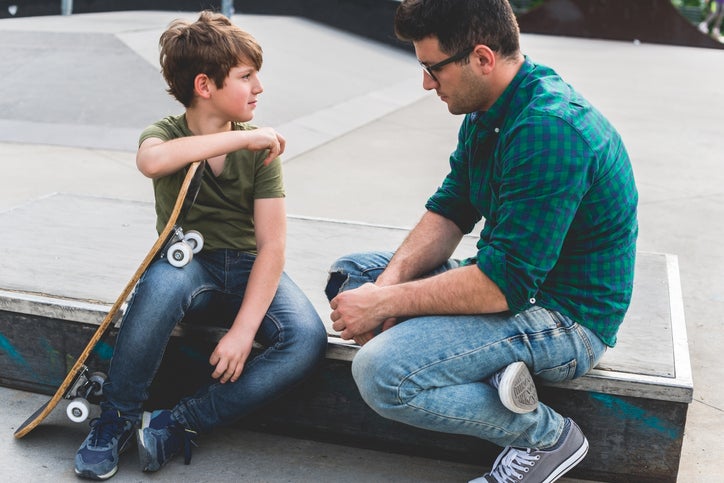-
When to Start Weaning Your Baby Off Baby Food

When babies are born, it’s easy enough to feed them. Breast or bottle, on-demand or on a schedule, and that’s pretty much the extent of the decision-making process. Once babies can sit up and hold their heads up on their own, you can start introducing pureed foods one at a time. As they grow, though, it gets a little more complicated. How do you know when it’s time to wean your little one from pureed baby food and start solids? We’ve got some useful advice.
Six months is typically the age at which babies start pureed foods. Be sure to offer a variety of foods, one at a time, because there’s evidence that this can help reduce the risk of allergies. As your child eats more foods, he or she will take less milk or formula. From pureed foods, you’ll move to mashed foods, then chopped, then small bites and finger foods.
Moving away from jarred foods is important because, although pureed foods and solids may be nutritionally equal, whole foods are better for a child’s development. Children need to learn to adapt to new things, and as they grow and learn to self-feed, they’ll be better able to develop the natural sense of appetite that will be important throughout their lives. By about the age of two, most healthy, typically developing children can eat the same foods as the rest of the family.
Of course, care must be taken to keep your toddler from choking. Keeping the food soft and not circular is part of preventing choking hazards. Find ways to make your toddler’s food finger-friendly, cutting it into small bites the child can pick up and chew. Pizza can be cut into small squares, soft fruit, soft cooked vegetables, or fully cooked eggs can be placed on the child’s tray to offer practice for finger feeding, and bread can be sliced into strips.
Use good practices to help your child develop good eating habits. Make sure you’re eating the same healthy fruits and vegetables you’re stressing for your child. Don’t cater to picky eaters by making different meals for different family members, but don’t be too strict about finishing meals, either. The important thing is to frequently expose your child to a variety of healthy foods. Allow children to serve themselves as much as is reasonable, and don’t insist on large portions. Set clear expectations, gently guide your children into eating healthy foods, and help them learn to trust their own appetites.
There are few things more rewarding than building a family and watching your little ones grow. At the Center for Vasectomy Reversal, we love helping people build their families. Under the direction of Dr. Joshua Green, our team provides state-of-the-art treatment for men who need a reversal of their vasectomy or have other fertility concerns. To learn more, contact us through our website, or call 941-894-6428 for a free consultation.
-
How to be Supportive During Your Partner’s Pregnancy

Many expectant parents are excited about the arrival of a new child, but sometimes, pregnancy brings a bundle of stress along with the joy. It’s easier to face the many changes, unknowns, and lengthy to-do lists when a man and woman act as partners in the pregnancy. A partnership strengthens the relationship, lowers anxiety, and increases the chance of a smooth transition into parenthood. Follow these tips to help you support your partner during her pregnancy.
Educate Yourself
The more you learn about your partner’s body and the changes she’s experiencing, the more effectively you can support her. It’s also wise to educate yourself about childbirth and infant development, so you know what to expect when the baby arrives. Here are some resources to guide you:
- Read pregnancy books with helpful week-by-week details.
- Attend childbirth classes and doctor visits where you can ask specific questions of educators and healthcare providers.
- Speak with other new parents, including friends and family, who may be eager to talk about how they navigated unique pregnancy challenges.
Provide Emotional Support
If you notice your partner struggling emotionally or dealing with high stress, step in with these tips:
- Encourage and reassure your partner.
- Ask her how you can help, and then follow through.
- Shower her with affection.
- Help her make difficult lifestyle changes, such as giving up alcohol alongside her.
- Encourage her to take breaks and rest more, being aware that pregnancy hormones increase a woman’s need for sleep.
- Talk to your partner about her desire for intimacy.
- Take walks together, where you can get some exercise and have time to talk.
- Reach out to a counselor, therapist, or healthcare provider if you feel your partner could use help for anxiety or depression.
Offer Physical Support
As your partner’s body undergoes tremendous change, be prepared to offer your physical support in the following ways:
- Take on more responsibilities at home, such as cooking and cleaning.
- Be open to eating different foods if your partner’s nausea or cravings change her usual diet.
- Don’t smoke around her. Seriously consider quitting or at least cutting back.
- Offer back massages and foot rubs to ease her stress and pain as the pregnancy progresses.
- Help her check items off that long to-do list.
- Make sure your partner knows you’re planning to be an involved father. This includes helping to feed, change, and bathe your baby to give her a break. If you have other children, volunteer to handle more of their care during the first few weeks of the baby’s arrival.
At the Center for Vasectomy Reversal, we love helping moms and dads build their families together. If you’re ready to begin your journey into parenthood, we’re here to help. Our team offers state-of-the-art treatment for men seeking vasectomy reversal under the direction of Dr. Joshua Green. To learn more, please call our Sarasota, FL clinic at 941-894-6428 and schedule a free consultation.
-
Fun Activities to Do With Your Children this Summer

Keeping the kids entertained while they’re out of school may seem like a daunting task at first, but with this list of activities on your summer bucket list, you’ll enjoy learning and playing with your children more than ever!
Outdoor Activities for Nice Days
Help the kids get some fresh air and explore nature when the weather is nice with these cheap or free activities.
- DIY bird feeders: Encourage your feathered friends to visit your backyard by making a bird feeder with your child’s help.
- Family hike: Planning a weekend outing on a local trail will give everyone in your family something to look forward to all week long.
- Bike ride and picnic: Put a meal together with your kids’ help, load the food into a backpack, and bike to a scenic picnic spot to enjoy your lunch as a family.
- Backyard obstacle course: Things such as traffic cones, hula-hoops, 2x4s, slides, pool noodles, and ropes strung between trees make for fun obstacles with minimal setup on your part.
Water Activities for Hot Days
Don’t let the heat stop you from going outside—introduce a little water to help everyone stay cool! Just remember to wear sunscreen and keep an eye on the youngsters.
- Water balloon piñatas: Tie water balloons to a clothesline to make piñatas for your kids and their friends.
- Water balloon baseball or volleyball: These classic games make for hours of water fun under the sun for the whole family.
- Sprinkler: Set up an oscillating sprinkler, and leave your kids to it!
- Water play: For younger kids, a small kiddie pool filled with a few inches of water and some plastic or rubber toys is just right.
Indoor Activities for Stormy Days
When summer rainstorms threaten to put a damper on your fun, try these indoor activities instead of resorting to videogames or TV.
- Balloon tennis: A few air-filled balloons and fly swatters are all you need for this family-fun activity.
- Indoor golf or croquet: Set up a course in your living room, or even all over the house, for tons of indoor fun when the weather won’t cooperate.
- Cooking or baking: Whether it’s whipping up a batch of cookies, making pancakes from scratch, or trying no-bake cake pops, summer is a great time to get your kids involved in the kitchen.
- Puppet theater: Got a few puppets in the toy chest? Make up a play with your kids or help them reenact their favorite movie.
Entertaining the kids may seem like a chore at times, but watching them grow and learn is also one of the most rewarding things you’ll ever do. If you’re ready to experience summer fun as a dad, the Center for Vasectomy Reversal can help you get there. Under the direction of Dr. Joshua Green, our team offers state-of-the-art treatment for men seeking vasectomy reversal. To learn more, please call 941-894-6428 or schedule a free consultation on our website.
-
The Science of Having a Boy or a Girl

Most parents-to-be want a healthy baby, but many also wish for a particular gender. You have probably heard rumors for tipping the odds in favor of one sex or the other, but are any of them true? Explore the science of having a boy or a girl.
The Father’s Sperm Determines a Child’s Gender
No matter what other factors may be at play, one thing is certain—the sex chromosome of the sperm that fertilizes the egg determines the baby’s gender at birth. If an X chromosome combines with the mother’s X chromosome, you get a girl (XX). And if a Y chromosome reaches the egg first, you get a boy (XY).
Factors that May Influence the Sex of a Child
Just about everyone has a nearly 50/50 chance of conceiving a boy or a girl. Having a family of all boys or all girls is almost always due to pure chance. Still, specific factors may slightly influence the odds that an X or Y chromosome sperm will fertilize the egg.
- The ovulation cycle: In the 1960s, the best-selling book, How to Choose the Sex of Your Baby, argued that timing sex close to ovulation allows fast-swimming Y sperm to reach the egg sooner, resulting in a male baby. And since Y sperm die quicker, intercourse far away from ovulation maximizes the chance of X sperm achieving fertilization, resulting in a female baby. However, this argument has been disputed over the years.
- Wartime: Some research has found a small correlation between higher male birth rates and times of war and conflict. This is an interesting find, given that male mortality rates are high during war.
- Stress: Other studies show that extreme stress can lead to female conceptions, which may be related to the fragility of Y sperm or the hormonal changes that tend to favor X sperm when the going gets tough.
- Wealth: A study of billionaires suggests that men who inherit their money are more likely to have sons than self-made billionaires (and the general population), suggesting that wealth without stress leads to sons.
- Mother’s diet: Some argue that eating cereal preconception induces male births, while others say low-salt, high-calcium diets favor females.
- The father’s family: A study of family trees found that fathers inherit a tendency to have more sons or daughters from their parents. Therefore, a man with many brothers is more likely to have sons, and a man with many sisters is more likely to have daughters.
With so many factors at play, most of which aren’t within your control, the odds end up being about the same as flipping a coin. And chances are, the moment you hold your newborn, it won’t matter to you whether it’s a boy or a girl.
Are you interested in having a vasectomy reversal so you can welcome a new son or daughter into the world? If so, please contact the Center for Vasectomy Reversal in Sarasota, FL at 941-894-6428 for more information.
-
Why you Should Let your Children have Pets

There’s something appealing about seeing kids and pets together. Especially if you’re an animal lover, the very idea of bringing a pet into your child’s life can conjure up idealistic images of kids playing, snuggling, and bonding with a new animal friend. But is it a good idea? There are many factors to consider, but there are plenty of great reasons to let your children have pets.
Before looking at the positives of pet ownership, let’s address the negatives. Pets are a big responsibility, and much of that responsibility falls on the parents. Having a pet requires a significant investment of time and money. Cats and dogs live for many years, so they require a commitment to an essentially permanent family member. Smaller pets, like goldfish and hamsters, don’t live as long, but their shorter lifespans present an emotional challenge. Pets require food, exercise, grooming, and veterinary care. Additionally, if a family member turns out to be allergic, you’re likely to have to experience the pain of rehoming a pet just as you’ve gotten attached.
Now that the negative aspects of pet ownership are out of the way, let’s look at all the wonderful things about getting a pet for your child.
- Pets can be good for a person’s health. In fact, research indicates that children who grow up with pets are at a lower risk of developing allergies and asthma. Pet owners require fewer trips to the doctor, and playing with dogs can lower blood pressure.
- Having a pet encourages exercise. Running, walking, playing, throwing a ball: pets give kids great reasons to head outside and get moving.
- Pets provide emotional benefits. Pets reduce stress, loneliness, and anxiety, and children with pets tend to have better impulse control, social skills, and self-esteem. Living with animals gives kids a healthy respect for nature, and children derive comfort from having an animal pal.
- Children learn while playing with pets. Caring for pets fosters responsibility, and nurturing a pet helps kids practice caregiving, developing empathy and compassion. Additionally, kids who are learning to read benefit from reading aloud to pets. Some studies even indicate that having pets helps kids become comfortable in leadership roles.
- Pets help a family to bond. Pets give families a common interest and can help slow the hectic pace of modern life. There’s even evidence to show caring for a pet together increases the sibling bond.
Pets are a great idea for a family with kids, as long as you make sure the pet you’re getting is a good fit for your family. When you’re ready to start a family, the Center for Vasectomy Reversal is here to help. Under the direction of Dr. Joshua Green, our team provides state-of-the-art treatment for men who need a reversal of their vasectomy or help with their fertility. To learn more, contact us through our website, or call 941-894-6428 to arrange a free consultation.
-
How to Discipline your Children

Being a parent is a hard job, especially because it’s your responsibility to teach your children how to be good people. Teaching your kids how to behave properly can be a challenge when there is so much conflicting information about discipline. Remember: discipline should be about guiding and teaching your children, not getting angry and punishing them. Here, we offer some tips for disciplining your children successfully.
- Set clear limits and firm consequences. Your rules should be clear and consistent, and the consequences should be established ahead of time. When a rule is broken, be prepared to follow through right away.
- Be positive whenever possible. Catch your children doing the right thing so that you can give positive attention and praise their successes. Even when you’re setting limits, try to phrase things in a positive way, telling them what they can do instead of just saying no.
- Take the time to listen. Especially with older kids, it’s important to hear your child’s point of view. When a child feels heard, he or she will be more likely to listen.
- Model the behavior you want to see. Stay calm when you’re correcting your child, both in your words and actions, and you’ll set a better tone for your household.
- Let some things go. If you’re always saying no, your child will begin to tune you out. On the other hand, sometimes ignored misbehavior delivers its own natural consequences. Prioritize, to avoid nagging.
- Avoid physical punishment. Spanking is a hotly debated topic, but most experts agree that it’s not a good idea. Research indicates that physical punishment is ineffective and causes long-lasting negative effects.
- Watch your words. Verbal abuse can be as painful as physical punishment, causing the same kind of long-term damage. Make sure the words you say to your children focus on building them up, rather than tearing them down.
- Set your child up for success. Pay attention to patterns in a child’s misbehavior and try to avoid situations that will stretch a child’s limits. Children who are hungry, tired, or overexcited are more likely to misbehave.
- Keep discipline age appropriate. Begin setting limits when your child is still an infant, and once he or she is a toddler, start using short time-outs and redirection to correct misbehavior. Preschool children are old enough for simple chores, and to begin learning about good choices and logical consequences. Older children need a balance of privilege and responsibility, and teens need clear boundaries and the opportunity to build decision-making skills.
Being a parent requires commitment and hard work, but it’s also extremely rewarding. If you’re ready to start a family, the Center for Vasectomy Reversal is here to help. Under the direction of Dr. Joshua Green, our team provides state-of-the-art treatment for men who need a reversal of their vasectomy or help with their fertility. To learn more, contact us through our website, or call 941-894-6428 to arrange a free consultation.
-
Common Questions Kids Ask and How to Answer Them

If there’s one thing kids know how to do, it’s ask questions. Unfortunately, sometimes the questions they ask come at inopportune times, and we as parents may not have ready answers. Heard any hard questions lately? We’ve compiled some tips on how to answer your child’s questions, as well as a list of questions you might hear.
When a child asks as questions, mirror the question back at the child; sometimes children are seeking validation for their feelings rather than concrete answers. Once you’ve mirrored what you believe is being asked, let the child ask a second time, to clarify the question. When answer, keep your answer age-appropriate and don’t the child more information than he or she can handle. Now, let’s look at some common questions.
- Why is the sky blue? Science questions are fun! The sky looks blue because that’s the color of the light in the air. When it’s time for sunrise or sunset, the molecules in the air spread out, and then the sky looks red or orange.
- What happened to the dinosaurs? Talking about dinosaurs can open up much bigger scientific conversations. The simple answer: an asteroid crashed into the earth when dinosaurs were alive, and it changed the planet. Dinosaurs died because they couldn’t adapt to the changes, and new animals that could live in the changed climate took their place.
- Where do babies come from? Before answering this question, take a breath. Make sure you know exactly what your child is asking, so you don’t give too much information when it’s inappropriate. Keep your answer simple and age-appropriate, but avoid confusion by using the correct terminology.
- Why do people speak different languages? This provides an opportunity to discuss other cultures and how we can learn from them. The short answer: a long time ago, people in different parts of the world invented different words for things, and languages grew from there.
- Why do we cover our private parts? Be matter of fact about this, explaining that it’s because we use those parts for things we don’t do in public. Talk about which body parts are off-limits to outsiders, while modeling a calm attitude about the body.
- Why do people get sick? Give a simple explanation, being careful to differentiate between common and more serious illnesses. Use the opportunity to discuss habits that help keep people healthy.
- What happens when people die? This answer will vary based on your beliefs, but remember, it’s ok to say you don’t know.
Having kids is sometimes a challenge, but it’s always a gift. If you’re ready to start your family, the Center for Vasectomy Reversal is here to help. Under the direction of Dr. Joshua Green, our team provides state-of-the-art treatment for men who need a reversal of their vasectomy or help with their fertility. To learn more, contact us through our website, or call 941-894-6428 to arrange a free consultation.
-
How to Teach your Children About Safety

Once you have kids, the world can seem like a frightening place. It’s easy to think of all the bad things that could happen to your vulnerable children, you want to protect them. At the same time, you don’t want your children to be fearful people, but rather friendly and openhearted. How do you teach your children to protect themselves from dangerous people without robbing them of innocent, joyous interactions with people in the world around them?
- Be aware that “stranger danger” is an oversimplified concept. Most child abduction and sexual abuse cases are committed by people who are not strangers to the children. Try teaching your children about suspicious behaviors, and consider using the term “tricky people” instead of “strangers”. Explain that while most people are good, some people try to trick children into breaking safety rules.
- Talk about safe strangers. Teachers, firefighters, and librarians are all examples of strangers that kids can go to for help. Teach your kids to seek help in a public place if something happens, and point out safe places to ask for help, like local stores and restaurants, or friends’ houses.
- Institute clear rules instead of overreaching guidelines. “Never talk to strangers” is not great advice, because you want your child to reply to the well-meaning grandmother in the grocery store or the librarian trying to help find a book. Try coming up with specific rules instead, like these examples:
- Don’t get in a car with anyone you don’t know.
- Don’t accept candy or food from strangers.
- Don’t go into anyone’s house without permission from a parent.
- Don’t listen to someone who wants you to disobey your parents.
- Don’t keep secrets from your mom and dad.
- Don’t do anything that makes you feel bad or uncomfortable.
- Get a trusted adult if someone you don’t know asks you for help.
- Teach your kids to trust their instincts. If something makes a child feel uncomfortable, he or she needs to know that it’s ok to say no. Teach the concept of consent, and role-play scenarios in which your children have to stand up for themselves.
- Encourage your kids to be assertive. Teaching kids “No, Go, Yell, Tell” is a good way to help them remember what to do in a dangerous situation. They should say no, run away, yell loudly, and tell a trusted adult. Practice this at home, so your child is ready in the event of an emergency.
Keeping kids safe is a big responsibility, but you’re up to the challenge. If you’re ready to start a family, the Center for Vasectomy Reversal is here to help. Under the direction of Dr. Joshua Green, our team provides state-of-the-art treatment for men who need a reversal of their vasectomy or help with their fertility. To learn more, contact us through our website, or call 941-894-6428 to arrange a free consultation.
-
Pool Safety

The weather is getting ever warmer, and soon it will be peak pool season! If you’re lucky enough to have a backyard pool, you probably can’t wait for the first pool party of the summer, or to watch your kids having fun out in the pool. It’s important to make pool safety a priority, though, because a fun day in the water can quickly turn tragic when parents aren’t paying attention.
Did you know that drowning is the leading cause of injury death in children between the ages of 1 and 4? The risk doesn’t end when kids leave preschool, either, and for kids aged 5-9, it’s the second leading cause of death, second only to motor vehicle accidents. Toddlers can drown in just an inch or two of water, but more than half of young children who die from drowning do so in home swimming pools.
What can you do to protect kids around water? Layer the safety measures.
- Fence the pool. Research indicates that over half of all swimming pool drownings of young children could be prevented with adequate fencing. All swimming pools, even temporary, above-ground pools, should be completely surrounded by a safety fence.
- Prevent kids from slipping outside without being seen. Safety gates, door locks, and doorknob covers should be your first line of defense, and all family members must be careful to shut doors after going outside.
- Be ready to perform a rescue. Have a shepherd’s hook and life preserver beside the pool, and learn how to swim and perform CPR.
- Teach kids to swim. Start getting your child used to the water early, around six months, and consider swim lessons by about age one.
- Never leave children alone around water. Supervision must be constant, your child needs your undivided attention, and the American Academy of Pediatrics recommends constant “touch supervision”, keeping kids within arm’s length.
- Designate a water watcher. An adult should be “on duty” at all times, to keep kids safe. If you’re the watcher, put down your cellphone, avoid distractions, and switch off with another adult when you need a break.
- Use life jackets and floaties. However, be careful not to let your guard down and trust those safety items to keep your kids safe without supervision.
- Don’t forget about additional hazards. Birdbaths, fountains, ponds, wells, and ditches are all hazardous to kids. Buckets, wading pools, and other water containers should be emptied as soon as you’re finished using them, as should trash cans or recycling bins that have collected rainwater. Inside, empty bathtubs after use, lock toilets, and don’t allow small children unsupervised access to bathrooms.
At the Center for Vasectomy Reversal, we love helping people build their families. Under the direction of Dr. Joshua Green, our team provides state-of-the-art treatment for men who need a reversal of their vasectomy or have other fertility concerns. To learn more, contact us through our website, or call 941-894-6428 for a free consultation.
-
Car Safety

The first U.S. patent for an automobile seatbelt was issued in 1885, but the first modern, 3-point seatbelt wasn’t installed in vehicles until 1959, and the first seat belt law didn’t come into play until 1968. Car seats were first created in the 1930s, but they were just for containing kids and letting them look out the window; it wasn’t until the 1960’s that the idea of car seats as safety devices came on the scene. In the nearly 50 years since then, car safety guidelines have changed quite a bit, and car seats are safer than ever. Are you doing everything you can to promote car safety for your kids?
- We all know that infant car seats are important, since the hospital won’t let you take the baby home without one. Little babies should be in a rear-facing car seat in the back seat, because that’s the best way to protect their heads and spines. A baby in the front seat is at risk from the airbags, and if he or she is forward facing or at the wrong recline angle, there’s a risk of restricting the airway.
- Use infant car seats the right way. Never hang toys from the carrier handle, because they could become flying projectiles in the event of an accident. Don’t put your baby in the infant seat in a puffy winter coat, because during a crash the coat can compress and make the baby less secure. Out of the car, don’t put the infant seat anywhere unsafe, like the top of a grocery cart or on a soft surface, and never let your baby nap in the car seat, because that raises the risk of sudden infant death syndrome (SIDS).
- As your baby grows, car seat safety is still just as important. Always know where your child is before you start your car, and use automatic door and window locks to keep your child safe. Follow the appropriate guidelines for when to move to a forward-facing seat or a booster, and use extreme caution if you’re considering a used car seat. Don’t let your kids transition to an adult seatbelt until they’re 4 feet 9 inches tall.
- Be aware that 46 percent of parents make a mistake when installing the car seat and putting the child into it. The seat should be tightly secured, with no more than an inch of movement from side to side or front to back. The harness must be secure, the chest clip even with the child’s armpits. Be careful to install car seats according to the manufacturer’s instructions, either using seatbelts or the LATCH system.
At the Center for Vasectomy Reversal, we love helping people build their families. Under the direction of Dr. Joshua Green, our team provides state-of-the-art treatment for men who need a reversal of their vasectomy or have other fertility concerns. To learn more, contact us through our website, or call 941-894-6428 for a free consultation.
Recent Posts
Popular Posts
categories
- Uncategorized
- Sperm Retrieval
- vasectomy reversal
- Emergency
- Dr. Green
- sperm count
- fertility
- male infertility
- MESA
- medical care
- low sperm count
- IVF
- male fertility testing
- anesthesia
- pregnancy
- sperm aspiration
- semen analysis
- post-vasectomy pain syndrome
- infertility
- VE
- anti-sperm antibodies
- older dad
- general anesthesia
- gender reveal party
- post-operative infections
- baby name
- parent
- baby's first year
- fertilization process
- spinal anesthesia
- ACS Fellow
- nutrition tips
- concierge-level care
- fertility planning app
- azoospermia
- out-of-town patients
- V-V
- post-vasectomy reversal
- conceiving
- vasectomy
- vasoepididymostomy
- smoking
- sperm quality
- baby registry
- infographic
- surgical care
- surgical consultation process
- prostate cancer
- baby gender
- family time
- COVID
- Baby Shower
- Child Care
- Halloween Costume Ideas for Babies
- Halloween
- Halloween Safety Tips
- Celebrity Infertility Spotlight
- Postpartum
- testosterone
- Father's Day
- Father
- Men's Health
- Thanksgiving
- Pregnancy Announcement
- Parenting Tips
- Sperm
